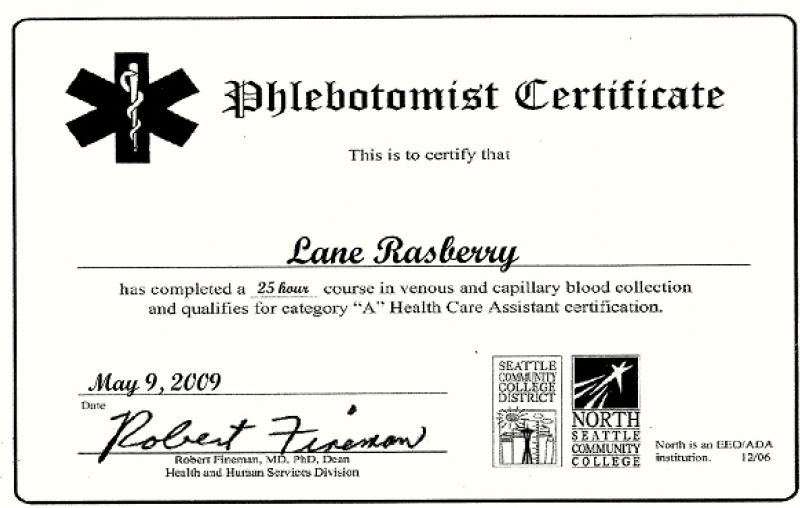What is a Phlebotomist?
A phlebotomist is someone who draws blood from patients to test for diseases, deficiencies and other problems.
Sometimes phlebotomists take blood for donations, research, or another testing, but all in all, a lot of blood samples are taken and sent off to labs to be tested.
It’s important for phlebotomists to have a good bedside manner, as it’s easier to take blood from someone who is relaxed and calm, rather than scared and crying.
If you want to become a phlebotomist, you’ll want to be sure you don’t have a fear of needles, and that your hand-eye coordination is near perfect.
Duties
Since you’ll be required to draw blood from patients, you’ll have many duties.
Some of them will include:
- Collecting blood samples from patients
- Use proper identification techniques, especially if you work in a hospital
- Labeling vials of samples
- Having the ability to find veins and using the best techniques to acquire blood from the patient
- Transferring samples to the required area
- Using sanitation methods so no cross-contamination occurs
Phlebotomist Salary
As of 2019, the average salary for a phlebotomist in the United States is around $34,000.
The range of salaries falls between $30,000 and $38,000.
This range in salary differs because of a person’s education, certification, and even where they work.
The longer that you work as a phlebotomist, the more money you will likely make due to promotions and raises.
People just started out as a phlebotomist will likely make less money to begin.
Those that work in smaller labs will likely make less than people who work in larger hospitals with more patients.
The main requirement to make more money is to become certified and keep up with your certification.
Annually National Average Salary: $44,390
Average Annual Salary by State
| State | Avg. Annual Salary |
|---|---|
| Alabama | $35,760 |
| Alaska | $49,720 |
| Arizona | $45,930 |
| Arkansas | $36,850 |
| California | $55,360 |
| Connecticut | $47,120 |
| Delaware | $46,170 |
| District of Columbia | $49,410 |
| Florida | $40,570 |
| Georgia | $43,700 |
| Hawaii | $48,210 |
| Idaho | $42,750 |
| Illinois | $45,090 |
| Indiana | $39,370 |
| Iowa | $40,060 |
| Kansas | $40,800 |
| Kentucky | $39,880 |
| Louisiana | $36,360 |
| Maine | $41,100 |
| Maryland | $49,590 |
| Massachusetts | $50,660 |
| Michigan | $42,350 |
| Minnesota | $45,810 |
| Mississippi | $36,240 |
| Missouri | $41,330 |
| Montana | $45,370 |
| Nebraska | $39,270 |
| Nevada | $44,390 |
| New Hampshire | $46,130 |
| New Jersey | $47,400 |
| New Mexico | $40,610 |
| New York | $50,860 |
| North Carolina | $41,240 |
| North Dakota | $48,330 |
| Ohio | $41,250 |
| Oklahoma | $41,040 |
| Oregon | $48,620 |
| Pennsylvania | $42,390 |
| Rhode Island | $48,820 |
| South Carolina | $40,190 |
| South Dakota | $38,390 |
| Tennessee | $39,520 |
| Texas | $42,290 |
| Utah | $39,470 |
| Vermont | $42,420 |
| Virginia | $44,840 |
| Washington | $50,910 |
| West Virginia | $38,980 |
| Wisconsin | $44,210 |
| Wyoming | $40,960 |
| Puerto Rico | $26,950 |
Annual Average Salary: Top 5 States
The top earning state in the field is California, where the average salary is $55,360.
These are the top 5 earning states in the field:
* Employment conditions in your area may vary.
How to Become a Phlebotomist
Step 1Get a Diploma or GED
Basically, this means finish high school or get your high school equivalent, a GED.
A GED is a general education diploma, for people that do not have a high school diploma.
Having either of these is a prerequisite to becoming a certified phlebotomist.
Another thing that you want to keep in mind is that you must be at least 18 years old in order to join any phlebotomist program.
This means you won’t have to be accepted to a college if that is not the path for you.
Even though the training program doesn’t require any extra college credits, it is possible to get an Associates degree in some schools.
This could lead to a career as a medical assistant as well.
If that’s not on your radar right now, that’s fine, phlebotomists make wonderful careers for themselves as well.
Step 2Enroll in a Phlebotomy Program
Depending on where you end up going, some programs can take as little as a few months, and in other places up to a year.
Some colleges offer phlebotomy programs, but you can find programs from independent training places as well.
For example, if you work in a hospital, you can get on the job training to become a phlebotomist.
Phlebotomy programs will teach you such things as anatomy, physiology, how to properly care for patients, laboratory techniques, and most of all how to take blood.
Step 3Gain Experience
That’s right, most of the training that comes from a phlebotomy program is going to be clinical.
No one wants you to walk around poking people with needles without some type of training, right?
This means that you’ll be working with test subjects at first, who you will need to poke with needles to make sure that you are doing the job correctly.
After you get some training, you’ll start working with actual patients.
Most of the time, this training is supervised by a lead phlebotomist.
Step 4Get Certified
Once you finish your program and start looking for employment, you’ll want to think about becoming certified.
Many employers won’t consider candidates that have not been certified, so keep that in mind.
You can take certification exams at state and national levels, it just depends on where you live.
States like California, Nevada, and Louisiana require certification to work.
Other states don’t require certification, but it will help you to gain more opportunities for employment.
It’s possible that in the future, all states will require certification.
Keep in mind that you will also need to keep up with your certification every 3 years.
Step 5Find a Job
That’s right.
After you get certified, and sometimes even before certification happens, you’ll need to find a job.
You’ll be able to work in plenty of places once you pass your program.
Finding phlebotomist technician jobs in your area will likely be easy, as they are in high demand.
You can also ask people that you worked with through the program if they have any job prospects for you.
Just remember, most employers would like you to be certified, so if you’re not yet, make sure you have plans to do so.
Education
One of the great things about getting into a career in phlebotomy is that you don’t need an excessive amount of formal education.
Typically, you can go to a phlebotomy program at a community college, or find a private program through a hospital or other clinics.
When you are in the phlebotomy program, you are going to learn things such as basic venipuncture techniques, butterfly techniques, fingerstick methods, as well as capillary punctures.
All the different types of punctures can be used on different people.
Typically, newborns take capillary punctures because they are so tiny.
Butterfly techniques are used for the elderly.
You’ll also want to make sure that the program you are in covers laboratory techniques.
This way you will understand how to work in a lab, safety precautions, and other helpful information.
Other information you’ll likely learn from your time in a training program include:
- How to put patients at ease during the procedure
- Verify a person’s identity to ensure proper labeling of blood
- Label the blood samples
- Enter information into the database
- How to process specimens for testing
After you complete the program, you are not limited in the places you can work or the types of job opportunities that are offered to you.
You can expect to find great opportunities at:
- Clinical labs
- Hospitals
- Nursing homes
- Research institutions
- Blood donation centers
- Public health agencies
- Independent labs
- Doctor’s offices
There are so many great places to work once you finish your training program.
This may seem like a lot to learn, but it doesn’t take much time.
Those that enter a phlebotomy program are typically done in less than a year.
Of course, if you want to try and go for a medical assistant degree, it may take you a little longer.
Medical assistant degrees are usually Associates degrees and can push your career to even greater heights.
Video About The Career
Certification
In most states, certification is not a requirement to gain employment.
That being said, it is still very important to become certified, and most employers won’t hire those that aren’t.
Certification doesn’t take long and will open up many different opportunities.
There are several places that will award you a certification:
American Society for Clinical Pathology
The American Society for Clinical Pathology requires that you have a high school diploma or equivalent and that you have passed a phlebotomy program within the last five years.
Your classroom training needs to include anatomy, physiology, specimen collection, specimen processing, and handling, as well as lab operations.
Another thing to remember is that the ASCP requires that the lab you train at must be regulated by the Clinical Laboratory Improvement Amendment of 1988.
This ensures that the lab you work in is up to date and safe.
American Society for Phlebotomy Technicians
In order to get certified through the ASPT, you’ll need to have worked as a phlebotomist part-time for one year, or 6 months full time.
You’ll also need a letter from a health care professional that states you are in good standing with the company that you work for.
The signature of the supervisor that you work for.
100 documented hours, and five documented skin punctures.
National Phlebotomy Association
The National Phlebotomy Association doesn’t have as many prerequisites as the others.
You’ll need venipuncture techniques.
As well as a hands-on clinical internship and 160 classroom hours.
National Health Care Association
The National Health Care Association requires that you have 30 venipunctures and 10 capillary sticks on live humans.
You’ll also need to have a high school diploma.
National Center for Competency Testing
In order to get certified with the National Center for Competency Testing, you’ll need to be a current student or graduated from a phlebotomy program.
Have completed one year of verifiable employment as a phlebotomy technician.
You’ll also need to have completed your phlebotomy training.
Certification Example:

Average Training Program Duration: 0-1 Year
The average training program for a phlebotomist can take from 4 weeks to almost a year.
It depends on which school you enroll in, and what state you live in.
Get ahold of local community colleges or private training sites to see where you fall as far as the duration of your training program goes.
Popular Programs
Job Outlook
The job outlook for certified phlebotomists is on the rise for the next ten years.
Data shows that this career is in high demand and will likely rise around 8 percent by 2026.
Blood samples are the most important pieces of information for doctors and other medical professionals to understand diseases, which means that phlebotomists aren’t going anywhere.
Those that work in hospitals and larger labs will have a higher job outlook, as there will be more patients and more samples to do.
Though those that work in smaller labs and doctor’s offices shouldn’t fear, the baby boomer generation is getting older, which means that more people are going to need to get their blood taken.
Employment Growth Projection: 8%
2023
2033
That's a higher than average projected growth of 11,000 jobs.
Phlebotomist: Interest Over Time
Should You Become a Phlebotomist?
Overall Satisfaction: Medium

The overall satisfaction for a phlebotomist is considered to be average in the United States.
The career has good opportunities for upward mobility, such as raises and promotions.
It does have quite a lot of stress attached, with long hours and medical needs.
Typically, anything in the medical field is going to be slightly more stressful than other occupations.
Work/life balance is great, and the hours seem to be satisfying as well.
Average Salary: Medium

The average salary for a certified phlebotomist is around $34,000.
Those that are just getting into the career will likely make around $30,000.
More advanced employees, those that have worked at the company for some time, can make up to around $38,000.
All of these salary amount factor in experience, education, and how long you’ve worked for the specific company.
Those that have certifications will likely make more than those that don’t.
Typically, those that aren’t certified will not get hired in certain companies.
Job Growth Outlook: High

The job growth outlook for a phlebotomist looks outstanding over the next ten years.
This career is on its way up, and there is no stopping it.
Blood analysis is an essential part of the medical field, though some of us would really love if there was another way to find out what’s going on in our bodies.
Phlebotomists are great for working in hospitals, but they are also important in donation centers and labs, as well as physician’s offices.
Education Duration: 0-1 Year

The education duration for a phlebotomist can take from four months to around one year to complete, that depends on which school you go to and how often you attend class, for example, if you are full time or part-time.
At the end of your training, you will gain a certificate or a diploma, depending on where you studied.
After you are trained, you are going to want to become certified.
Though this is not necessary for all states, it is highly recommended, as many employers look for that certification.
Certification will include an exam and typically experience in the field.
Personal Skills Needed

Though you will spend a lot of time taking blood in this career, you’ll also need some other skills:
- Customer service skills
- Attention to detail
- Work well under pressure/at a fast pace
- Sensitivity and understanding
- Patience
- Ability to remain calm in stressful situations
One thing to keep in mind when working in this field is that the patients are probably scared, nervous, or worried.
Allowing yourself to give them some empathy and treat them with respect, and you will go far in this career.
Frequently Asked Questions
Q. What is a certified phlebotomist?
A certified phlebotomist is someone who draws blood samples from patients for tests, donations, or other medical reasons.
In order to be a successful phlebotomist, you must do two things.
First, become certified so that you are legally capable of drawing blood from patients.
Second, have a great bedside manner.
Many patients are nervous and worried about giving blood, having a positive attitude can help patients tremendously.
Q. How much does a phlebotomist make?
On average, a phlebotomist will make around $34,000 a year.
Depending on the amount of education and certification that you have, you could make more.
Potentially, those that work longer in the career will have more chances for promotions and raises, which can raise the salary to around $38,000.
It’s also possible to get a certification as a Donor Phlebotomy Technician, which means you can work at donor sites, cashing in more money if you wish.
Q. How much does it cost to become a certified phlebotomist?
Training to become a phlebotomist can be expensive because there are several different things that you’ll have to do in order to become certified.
The training costs can vary from state to state, some states the training costs are around $200, while they can be as much as $3,000 in other states.
The most important factor to keep in mind is that the school you choose to get your certification from is accredited and appropriate, that will teach you all that you need to know to be a great phlebotomist.
The certification will cost around $50, sometimes upwards of $150.
It is important to also keep in mind that you will need a lot of experience, so online classes may be convenient, but won’t give you the hands-on attention you need.
Q. What is the demand for phlebotomists?
In the next ten years, the phlebotomy career is looking to grow 8 percent.
This means that there is a high demand for phlebotomists.
The outlook for this career is outstanding compared to many others in the same field.
You can expect to find work in hospitals, diagnostic treatment centers, blood donation centers, as well as other places in your area.
Q. How long does it take to become a phlebotomist?
There are several different companies that allow you to become a certified phlebotomist, and they all have different duration times.
Some companies will allow you to become certified within four months.
While others may take up to eight months.
You also need to remember that you’ll need training in order to complete the program.
Typically, programs ask that you have 100 hours of training, so depending on how fast you can get that done, you’ll be on your way to becoming a certified phlebotomist that much quicker.










I already have my Certification through NHA for phlebotomy (August 2020) But I need skills training and an externship in order to get my license in California. Can the Red Cross help me complete my Licensing requirements? I live in Fresno CA and spend a lot of time in Merced CA, caring for my mother as well.
I am hopeful.
I would like to study for phlibatomy
Hello My name is Gregory McCastle
My question: is there an (Age range restriction) as or to become a Certified Phlebotomist?
I am an older adult. I was certified in EKG/ECG – Phlebotomist – CNA/PCT in 2005.
A.A.S. – Medical Billing Specialist and more Higher Education
I am a College Graduate
*However I provided, Total inpatient home comfort care for both parents until both passing
Father 2011 and Mother 2014
I want to refresh my knowledge again, I worked as phlebotomist in eighties while I was College student. Now I have retired from just need something to do to bring in some income. I am a experienced Phlebotomist. I love to do something to help people get better. I worked for 3 years at Carolina Medical center when I move from Roanoke, VA, to charlotte NC from 1993 to 1995 part time. Look forward to hear from you.
Is there a training program that can be free for students of low income? I’m in the need of taking the course because I love it and also I’m interested in a health career but for now I don’t have the money to cover the phlebotomy course.
Hello,
I’m looking for information on your program.
Coast,location and prior experience needed.
Thank you for your time.
Been thinking about getting my phlebotomy certification for a while now.
Phlebotomy is growing fast and to me it’s a sign that I need to jump early into this profession before more people do.
I appreciate you taking the time to write all of this information, really helpful!
Becoming a phlebotomist seems exactly what I was looking for, a medical field that has high job growth but is not something too difficult to learn and not too long of a training.
Thanks for an awesome guide (: